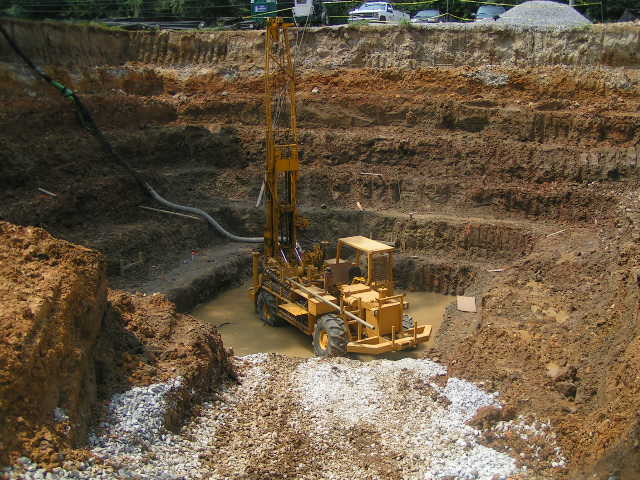The Value of Soil Evaluation and Site Examination in the Geotechnical Industry: Ensuring Security and Security in Civil Engineering
In the geotechnical industry, soil analysis and website investigation are fundamental elements that underpin the security and stability of civil engineering jobs. By thoroughly understanding soil residential or commercial properties, engineers can preemptively attend to possible challenges, eventually securing structural honesty.
Understanding Soil Residences
In the world of geotechnical engineering, a thorough understanding of dirt residential or commercial properties is paramount for informed decision-making and effective task style. The characterization of dirt involves the evaluation of different physical and mechanical homes, such as grain dimension distribution, plasticity, leaks in the structure, cohesion, and shear stamina. These residential or commercial properties determine exactly how soil behaves under different loading conditions and environmental impacts, making them essential for evaluating website viability for construction jobs.
Dirt category systems, such as the Unified Dirt Category System (USCS) and the AASHTO classification, give structures for grouping soils based on their qualities. This category help designers in predicting actions under anxiety, water flow, and settlement, thereby influencing style options and building and construction strategies.
Furthermore, the interaction between dirt and surrounding structures is a vital factor to consider in geotechnical design. Understanding dirt properties aids determine prospective difficulties, such as liquefaction in earthquake-prone areas or excessive settlement in soft dirts. By thoroughly reviewing these buildings, geotechnical designers can make sure the security, security, and durability of structures, eventually adding to the overall durability of civil engineering tasks.
Techniques of Soil Evaluation

In-situ tests consist of methods such as Common Penetration Tests (SPT), Cone Infiltration Tests (CPT), and vane shear examinations. SPT examines the resistance of dirt to infiltration, giving data on thickness and stamina, while CPT measures dirt resistance and pore pressure, yielding constant profiles of soil stratigraphy. Vane shear tests are specifically beneficial for analyzing the shear stamina of cohesive dirts.
Lab tests complement these in-situ analyses and include sampling dirt for regulated testing. Common laboratory methods include Atterberg limits, which identify the plasticity qualities of fine-grained dirts, and compaction examinations, which assess moisture-density partnerships. Extra tests, such as triaxial compression and unconfined compression examinations, are conducted to evaluate the shear strength of dirt examples under numerous problems.
Role of Website Investigation
Site investigation plays a pivotal role in the geotechnical design process, functioning as the foundation for recognizing subsurface problems. This comprehensive evaluation involves systematic expedition of dirt and rock residential properties, groundwater levels, and various other geological attributes that influence task safety and stability.
Commonly, site investigations encompass a variety of techniques, including drilling boreholes, tasting, and in-situ screening. These approaches offer important information on the physical and mechanical characteristics of the ground, notifying designers concerning prospective challenges such as dirt negotiation, birthing capability, and incline security.
Furthermore, site investigation helps with the recognition of unsafe products and impurities, making it possible for the implementation of proper removal procedures. By establishing a precise subsurface profile, website examinations help to alleviate dangers connected with construction, making certain that tasks stick to security criteria and regulations.
The searchings for from an extensive website investigation not only overview style choices yet likewise affect construction methodologies and timelines. see post In summary, the importance of site examination can not be overemphasized; it is a crucial step in the geotechnical engineering process, laying the foundation for successful project implementation while prioritizing public safety and ecological integrity.
Impact on Project Style
A comprehensive understanding of soil features substantially affects job layout in the geotechnical market. Dirt evaluation notifies designers concerning the mechanical homes, make-up, and actions of the ground, which are vital elements in determining the usefulness and safety and security of a construction project. Accurate information on soil stamina, compressibility, and permeability enable the growth of reliable foundation designs, ensuring that structures are effectively sustained and steady throughout their life-span.
Additionally, the visibility of impurities or unsteady dirt layers can prompt alterations in job layout, such as choosing alternative construction approaches or materials. This proactive technique minimizes threats connected to dirt settlement, extreme loading, or lateral activity, engineer of record thus safeguarding both the honesty of the structure and public safety and security.
The combination of soil evaluation right into task design also facilitates compliance with ecological considerations and regulative demands. By attending to soil-related challenges early in the layout procedure, engineers can enhance resource allocation and reduce possible why not try this out delays and prices related to unexpected website conditions. Inevitably, thorough soil evaluation enhances the overall quality and resilience of civil engineering projects, bring about even more sustainable and resistant infrastructure.
Instance Researches and Examples
Showing the critical role of dirt analysis in the geotechnical market, numerous study highlight its impact on project outcomes. One notable instance is the building of a skyscraper in downtown Los Angeles, where comprehensive soil testing exposed unsteady subsurface conditions. geotechnical engineers. By identifying the existence of expansive clay, designers had the ability to upgrade the foundation, integrating deep pilings that guaranteed stability and security, eventually stopping prospective architectural failings

Finally, a dam project in the Southeast faced delays as a result of unforeseen dirt erosion concerns. In-depth soil analysis permitted designers to apply efficient stabilization strategies, making certain that the dam satisfied safety and security policies while sticking to the job timeline. These cases underscore the need of comprehensive dirt analysis and website examination, highlighting their necessary role in accomplishing secure and effective civil engineering tasks.
Final Thought
Finally, dirt analysis and website investigation are essential components of the geotechnical market, playing a vital duty in ensuring the safety and stability of civil design projects. By giving necessary data on dirt residential properties and subsurface conditions, these processes educate foundation style and construction methods. Additionally, complete investigations add to threat identification and danger reduction, ultimately improving the long life and resilience of frameworks while maximizing source allocation throughout the project lifecycle.
In the geotechnical sector, soil analysis and site investigation are foundational aspects that underpin the security and security of civil engineering tasks. Understanding soil buildings assists recognize prospective challenges, such as liquefaction in earthquake-prone areas or extreme settlement in soft dirts. SPT reviews the resistance of dirt to infiltration, giving information on density and toughness, while CPT gauges soil resistance and pore stress, yielding continuous profiles of dirt stratigraphy. These instances emphasize the requirement of extensive soil evaluation and website investigation, highlighting their necessary role in accomplishing effective and risk-free civil design projects.
In verdict, dirt evaluation and website examination are basic elements of the geotechnical market, playing an important function in guaranteeing the safety and stability of civil design projects.